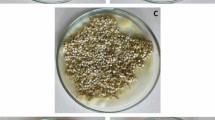Abstract
Kernels of sixty groundnut genotypes comprising thirty each of Spanish and Virginia groups were characterized and compared for the content of oil, protein, phenols and antioxidant activity along with their fatty acid and sugars profiles. The antioxidant activity for Virginia genotypes was ranged from 12.5 to 16.5 μM Trolox equivalent activity for Spanish genotypes ranged from 6.8–15.2 μM. Amongst Virginia types, the highest oleic acid/linoleic acid (O/L) ratio of 2.38 was observed for NRCG 12312 while from Spanish group the highest O/L ratio of 1.24 was observed for NRCG 12731. The sucrose content for Virginia genotypes ranged from 38.5 to 69.0 mg/g while it was 27.9 to 53.3 mg/g for Spanish genotypes. Average myo-inositol content was higher for Spanish genotypes (0.8–2.1 mg/g) compared to Virginia (0.4–1.8 mg/g) while the reverse was true for stachayose content (Spanish: 3.5–7.9 mg/g; Virginia: 4.6–10.3 mg/g). Thus, Virginia genotypes could be preferred to Spanish genotypes for better oil stability and antioxidant activity.




Similar content being viewed by others
References
Arnao MB, Cano A, Acosta M (2001) The hydrophilic and lipophilic contribution to total antioxidant activity. Food Chem 73:239–244
Asibuo JY, Akromah R, Adu-Dapaah HK, Safo-Kantanka O (2008) Evaluation of nutritional quality of peanut (Arachis hypogaea) from Ghana. African J Food Agric Devel 8:133–150
Bishi SK, Kumar L, Dagla MC, Mahatma MK, Rathnakumar AL, Lalwani HB, Misra JB (2013) Characterization of peanut germplasm (Arachis hypogaea L.) for flatus sugars and fatty acid composition. Ind Crop Prod 51:46–50
Bishi SK, Kumar L, Mahatma MK, Khatediya N, Chauhan SM, Misra JB (2015) Quality traits of Indian peanut cultivars and their utility as nutritional and functional food. Food Chem 167:107–114
Bryant RJ, Rao DR, Ogutu S (2004) α and β-galactosidase activities and oligosaccharide content in peanuts. Plant Food Hum Nutr 58:213–223
Clements RS, Darnell B (1980) Myo-inositol content of common foods: development of a high-myo-inositol diet. Am J Clin Nutr 33:1954–1967
Croze ML, Soulage CO (2013) Potential role and therapeutic interests of myo-inositol in metabolic diseases. Biochimie 95:1811–1827
Gaydou EM, Bianchini JP, Ratovogery J (1983) Triterpene alcohols, methyl sterols, sterols and fatty acids in five Malagasy legume seed oils. J Agric Food Chem 31:833–836
Griel AE, Eissenstat B, Juturu V, Hsieh G, Kris-Etherton PM (2004) Improved diet quality with peanut consumption. J Am Coll Nut 23:660–668
Hammer O, Harper DAT, Ryan PD (2001) PAST – PAlaeontological STatistics, ver. 1.89. Palaeontol Electronica 4:1–9
Isanga J, Zhang GN (2007) Biologically active components and nutraceuticals in peanuts and related products. Review Food Rev Int 23:123–140
Jackson DA (1993) Stopping rules in principal components analysis: a comparison of heuristical and statistical approaches. Ecology 74:2204–2214
Jiang R, Manson JE, Stampfer MJ, Liu S, Willett WC, Hu FB (2002) Nut and peanut butter consumption and risk of type 2 diabetes in women. J Am Med Assoc 288:2554–2560
Kris-Etherton PM, Yu-Poth S, Sabaté J, Ratcliffe HE, Zhao G, Etherton TD (1999) Nuts and their bioactive constituents: effects on serum lipids and other factors that affect disease risk. Am J Clin Nutr 70:504S–511S
Kris-Etherton PM, Hu FB, Ros E, Sabaté J (2008) The role of tree nuts and peanuts in the prevention of coronary heart disease: multiple potential mechanisms. J Nutr 138:1746S–1751S
Mercer LC, Wynne JC, Young CT (1990) Inheritance of fatty acid content in peanut oil. Peanut Sci 17:17–21
Misra JB, Mathur RS (1998) A simple and economic procedure for transmethylation of fatty acids of groundnut oil for analysis by GLC. Int Arachis Newsletter 18:40–42
Nautiyal PC, Ravindra V, Rathnakumar AL, Ajay BC, Zala PV (2012) Genetic variations in photosynthetic rate, pod yield and yield components in Spanish groundnut cultivars during three cropping seasons. Field Crop Res 125:83–91
Niemenak N, Rohsius C, Elwers S, Ndoumou DO, Lieberei R (2006) Comparative study of different cocoa (Theobroma cacao L.) clones in terms of their phenolics and anthocyanins contents. J Food Compos Anal 19:612–619
O’Byrne DJ, Knauft DA, Shireman RB (1997) Low fat–monounsaturated rich diets containing high-oleic peanuts improve serum lipoprotein profiles. Lipids 32:687–695
Oupadissakoon C, Young CT, Mozingo RW (1980) Evaluation of free amino acid and free sugars contents in five lines of Virginia-type peanuts at five locations. Peanut Sci 5:31–34
Pattee HE, Isleib TG, Giesbrecht FG, McFeeters RF (2000) Relationships of sweet, bitter, and roasted peanut sensory attributes with carbohydrate components in peanuts. J Agric Food Chem 48:757–763
Rosales-Martínez P, Arellano-Cárdenas S, Dorantes-Álvarez L, Felipe García-Ochoa F, López-Cortez MS (2014) Comparison between antioxidant activities of phenolic extracts from Mexican peanuts, peanuts skins, nuts and pistachios. J Mex Chem Soc 58(2):185–193
Salway JG, Whitehead L, Finnegan JA, Karunanayaka A, Barnett D, Payne RB (1978) Effect of myo-inositol on peripheral-nerve function in diabetes. Lancet 2:1282–1284
Sarvamangala C, Gowda MVC, Varshney R (2011) Identification of quantitative trait loci for protein content, oil content and oil quality for groundnut (Arachis hypogaea L.). Field Crop Res 122:49–59
Teres S, Barcelo-Coblijn G, Benet M, Alvarez R, Bressani R, Halver JE, Escriba PV (2008) Oleic acid content is responsible for the reduction in blood pressure induced by olive oil. P Natl Acad Sci USA 105:13811–13816
Yu J, Ahmedna M, Goktepe I (2005) Effects of processing methods and extraction solvents on concentration and antioxidant activity of peanut skin phenolics. Food Chem 90:199–206
Author information
Authors and Affiliations
Corresponding author
Rights and permissions
About this article
Cite this article
Mahatma, M.K., Thawait, L.K., Bishi, S.K. et al. Nutritional composition and antioxidant activity of Spanish and Virginia groundnuts (Arachis hypogaea L.): a comparative study. J Food Sci Technol 53, 2279–2286 (2016). https://doi.org/10.1007/s13197-016-2187-y
Revised:
Accepted:
Published:
Issue Date:
DOI: https://doi.org/10.1007/s13197-016-2187-y




